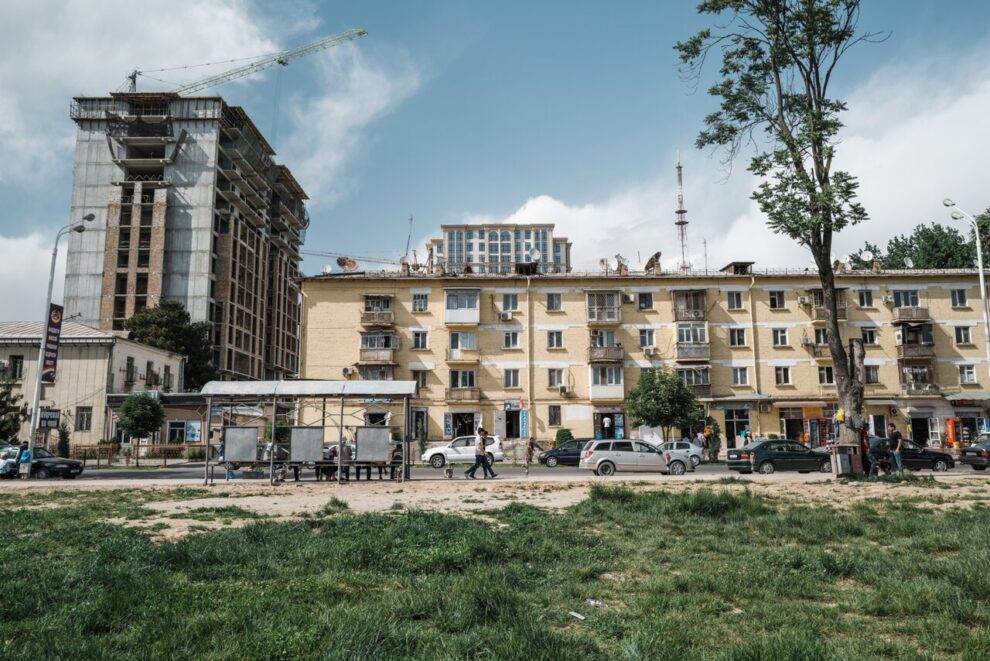Known as Stalinabad from 1929 to 1961, Dushanbe has been shedding its Soviet past for years now. In their quest to foster a post-independence national identity, the Tajik authorities have systematically demolished Soviet-built landmarks (like the former presidential palace and the Mayakovsky Theater) to make way for high-rise apartment blocks, new infrastructure, and even more imposing government buildings. Real estate developers have also gotten in on the reconstruction boom, putting up apartment towers that overtop their older counterparts and displacing local residents in the process. As a result, public outcry over the loss of historic buildings has given way to more practical concerns about costs and consequences of redevelopment. In a dispatch from Dushanbe, journalist Judith Robert reports for The Beet.
Living in Dushanbe often means rediscovering the city as if you were returning to it after a decade away. You walk over to your local post office, only to discover that it’s being torn down. You go to your second favorite fast-food spot — the first was knocked down a few weeks ago — and find that it, too, is now surrounded by the green fencing that has become synonymous with eviction.
At countless building sites across the city, Soviet Stalinabad is giving way to independent Dushanbe. Skyscrapers are replacing the low-rise buildings Russian architects designed in the 20th century, and quaint tree-covered streets are being turned into monumental avenues. These changes have divided public opinion, prompting nostalgic calls to preserve the city’s architectural heritage and more practical concerns about the social and environmental costs of redevelopment.
Apparently, the authorities keep a list of protected historic buildings and monuments. But as of February 2022, it reportedly only included 12 buildings in Dushanbe. Meanwhile, the list of razed landmarks continues to grow, and the city’s remaining “calling cards” — as locals call them — seem to be waiting their turn.
Goodbye, Stalinabad
Dushanbe was a Soviet city par excellence. When the USSR detached Tajikistan from Uzbekistan in 1929 and named it a separate republic, its capital was a village with less than 6,000 inhabitants best known for its Monday market (so much so that its name comes from the Persian word for “Monday”). The Soviet authorities promptly renamed the city after Stalin and dispatched specialists from Moscow and Leningrad to develop it into a metropolis.
From the 1930s onwards, a string of Russian architects strove to give Stalinabad a modern, Soviet face, beginning with the “Leningrad-classical” style. Today, not a trace of the pre-Soviet village remains — Dushanbe’s oldest building is just over 90 years old.
Rumors surface regularly about the next target for demolition, as was the case last year with School No. 1 (constructed in 1932) and, more recently, the famous Rohat Teahouse, an institution where locals and tourists have mingled for decades. Although the authorities denied the rumors in both cases, this is usually how the teardowns begin: word of mouth precedes a last-minute official announcement, leaving activists little time to oppose the decision.
The authorities spared the Rohat when nearby buildings were knocked down in 2022, and regulars feel confident that the teahouse is untouchable. “As long as I’m alive, they won’t destroy the Rohat,” a 75-year-old patron told The Beet. “We wouldn’t let that happen,” his neighbor added. “These are just rumors.”
In most cases, however, the authorities have shown little attachment to the city’s Soviet architecture — even in the face of public outcry. Since 2015, Dushanbe’s most famous buildings have disappeared one by one, making way for new administrative buildings (such as the new parliament and government complex that’s still under construction) or infrastructure to facilitate automobile traffic.
“In Tajikistan, there isn’t the same idea of what ‘heritage’ is as in the West,” explained Paul Wolkenstein, an architect and doctoral researcher studying Soviet architecture in Central Asia and the Caucasus. “In some countries, if a building from the 1970s is considered remarkable, you protect it. In Tajikistan, you don’t: you rely on [a building’s] age to determine [its] value.”
The list of protected architectural monuments is also subject to revision. According to media reports, the former presidential palace — a neoclassical structure built in 1957 to house the Tajik Communist Party’s headquarters — appeared on the list in 2016 but was no longer included in 2020 when the authorities decided to tear it down. The decision sparked debate on social media, with some residents calling for the building to be preserved and put to another use.
“When we’re told that this building has exhausted its usefulness, this is at the very least dishonest; this is a lie. You take a look at its granite cladding [and] wonderful architecture. Preserving our history is very important,” historian Gafur Shermatov told the news outlet Asia-Plus at the time. (The presidential palace was demolished nonetheless.)
For others, however, Soviet buildings aren’t necessarily a welcome inheritance. “There are people who defend [Tajikistan’s] Soviet buildings and heritage, but given what’s happening in Ukraine and the region, it seems to me that this cultural question should be posed from another angle,” said Tahmina Inoyatova, a doctoral researcher focused on the intersection of identity, power, and urban space in Tajikistan.
“Why do we need to protect Soviet buildings? Why do we need to save them?” Inoyatova continued. “And why did these buildings built by Russian engineers and architects appear in this place? There are more profound questions to ask.”
“In neighboring countries such as Kyrgyzstan and Kazakhstan, civil society and history buffs are mobilizing to prevent demolitions. This movement is also beginning to emerge in Uzbekistan. [But in] Tajikistan, even living architects whose works are being destroyed sometimes agree with the decision,” said Wolkenstein.
Demolitions and displacement
While Gafur Shermatov is certainly not alone in believing that Dushanbe’s Soviet-era buildings have historical value, ordinary residents are often more concerned about the fate of their own homes. Property development has exploded in Dushanbe in recent years, giving rise to forced evictions and illegal demolitions. According to the authorities, the city’s redevelopment is taking place according to a general plan, but the document remains under wraps.
“If you want to meet people who have been relocated, it’s easy,” said a 17-year-old Dushanbe resident (who asked to remain anonymous). He went on to list his acquaintances whose homes had been flattened in recent years. “All you have to do is take an evening stroll along Ayni [one of the city’s main streets] and talk to people. You will find displaced residents around every corner.”
The demolitions are discussed widely, but people are often hesitant to protest too vigorously. At least two human rights defenders working on this issue have been jailed: journalist Daler Bobiev, who covered unlawful housing demolitions and other social issues on his YouTube channel, and lawyer Abdulmajid Rizoev, who represented people whose Dushanbe homes were slated for demolition. Rizoev was released in May, while Bobiev is still serving a 10-year prison sentence.
According to Inoyatova, however, some residents have nevertheless pushed back. “There’s this stereotype about Central Asia that people don’t protest or speak out against the demolitions. In reality, this is not the case,” she told The Beet. “If you talk to people who oppose these demolitions, you’ll understand they’re very vocal.”
While some people have managed to negotiate compensation agreements with private developers, others have had to turn to the courts. Inoyatova says this yields mixed results, but some have managed to win their cases. “They’re almost never able to save their homes from demolition, but what they can do is obtain better [living] conditions for themselves: a better apartment, for example,” she explained.
For those who do make deals with developers, the process of obtaining new housing can still take months or even years. In some cases, the construction of new residential buildings has ground to a halt due to corruption scandals. Other new-builds have turned out to have serious structural or administrative problems, ranging from inadequate ventilation and a lack of legal documentation to unfinished utility lines and multi-story buildings without working elevators.
Then there’s the fact that many new residences are far too expensive for the average Tajik citizen. According to Asia-Plus, the going price for a new apartment in Dushanbe typically ranged from $450 to $1,000 per square meter in 2022. By comparison, the average monthly salary in Tajikistan is less than $200.
Natural disasters
Shoddy construction work and apparent non-compliance with building regulations have made many Dushanbe residents mistrust new housing developments. And Tajikistan’s long history of natural disasters only compounds fears that new buildings are unsafe.
Since Dushanbe is a high-risk seismic zone, the authorities often invoke compliance with earthquake building standards when justifying demolitions. But since developers have been replacing the city’s Soviet-built low-rises with much taller buildings, locals remain skeptical.
“People often say that it used to take much longer to build foundations than it does now. Today’s technologies have nothing to do with Soviet-era ones, but people fear the speed [of construction]. They think that speed means poor quality,” Inoyatova explained.
Following the devastating earthquakes in Turkey and Syria last February, the head of Dushanbe’s Architecture and Construction Committee, Nizom Mirzozoda, claimed that buildings in the capital could withstand up to magnitude nine quakes. Tremors from two earthquakes in Tajikistan’s north, measuring six or less on the Richter scale, reached Dushanbe last March. Though there was no reported damage in the capital, this was enough to worry the population.
The construction boom is also making the city less safe in other ways, particularly in the context of the global climate crisis. This past summer was the planet’s hottest ever recorded; in Dushanbe, thermometers regularly shot up to 35–40 degrees Celsius or more (95–104 degrees Fahrenheit), posing health risks for residents. Moreover, desertification in parts of neighboring countries like Uzbekistan and Afghanistan has led to an increase in sandstorms.
Dushanbe’s air quality regularly passes dangerous pollution thresholds and new high-rises allow less air circulation than low-rise buildings. This creates pockets of the city with particularly poor air quality. The ubiquitous building sites also produce greater quantities of dust that can do damage to residents’ health.
“Last summer showed how terrible it can be to live in Dushanbe, with one million inhabitants, in the context of climate change,” Inoyatova told The Beet. “Nothing like this had ever happened before.”
In the past, Dushanbe’s tree-lined streets made the summer heat more bearable. According to historian Gafur Shermatov, Soviet architect Pyotr Vaulin, who led the team that drew up the original plan for the city, admired Le Corbusier and wanted to implement his idea of the “green city.” Botanist Vera Zapryagayeva continued this project in the late 1950s, working to plant trees and preserve green spaces throughout Dushanbe.
While there are still gardens in the city center, reconstructed avenues are noticeably less green. Razing Soviet-era residential buildings has also involved cutting down trees that grew in their courtyards, and the authorities recently cut down older trees in one of the city’s main parks. While young trees have been planted in some places, they will take decades to provide the cover needed for effective cooling.
Onwards and upwards
Tajikistan put up 1.75 million square meters (18.8 million square feet) of residential real estate in 2022, up from 1.43 million square meters (15.3 million square feet) in 2021. With worksites seemingly on every corner and the sounds of construction continuing even at night, the pace of redevelopment is showing no signs of slowing down.
In Dushanbe, the authorities have introduced new regulations for developers and, in the wake of the earthquakes in Turkey and Syria, formed a committee tasked with re-examining municipal construction standards and inspecting the seismic resistance of new buildings. Nevertheless, locals still see the real estate sector as corrupt and tend to believe that only the interests of developers are taken into consideration.
“When you know how these companies work, not just in Tajikistan but throughout Central Asia and in other regions, you understand that there is corruption, bribes, [and] offshore resources. It’s not a Tajik problem, it’s a global economic problem,” Inoyatova said.
Even Dushanbe’s mayor, Rustam Emomali, has called for tighter building controls. The son of Tajik President Emomali Rahmon, who appointed him mayor of the capital in 2017, Emomali is seen as closely connected to the city’s transformation. “The process of redeveloping the city is linked to [Emomali’s] personal image. He took responsibility before the population [and said], ‘If you have any problems, you turn to me,’” Inoyatova recalled.
Indeed, the 35-year-old mayor has made building safety his pet project, putting his reputation at stake amid rumors that Rahmon expects him to take over as president one day.
The financing sources for the government’s construction projects have also raised questions, especially given that Tajikistan is Central Asia’s poorest country. Some major projects have relied on foreign funding, such as the construction of Tajikistan’s largest mosque — a 10-year endeavor that cost an estimated $100 million, 70 percent of which came from Qatar.
China is also an important source of loans and investments for the Tajik government, but the details of these agreements aren’t usually publicly available. Additionally, Beijing has provided Tajikistan with so-called “no-strings” aid, including $350 million to fund the construction of the new parliament and government complex on the site of the former presidential palace in Dushanbe. The new complex, made up of sprawling buildings 13 to 15 stories high, will reportedly be completed in 2024.
Source: Meduza









